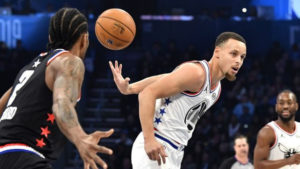 Welcome to Atomic Wonder, where we break down one tiny thing with big ripple effects. This week, we’re talking about the behind-the-back pass.
Welcome to Atomic Wonder, where we break down one tiny thing with big ripple effects. This week, we’re talking about the behind-the-back pass.
It’s June 19, 2016. The world is Stephen Curry’s oyster, the ball’s in his hands with just over five minutes left in Game 7 of the NBA Finals against the Cleveland Cavaliers. He’s dribbling up the open floor, his playground of choice, where he is an unpredictable orb of pure possibility. The only pertinent question in that moment, in that year: What will he do next?
The answer: Turn it over. Oops.
Curry’s former coach Mark Jackson provides the subtitles on play-by-play: “That’s a bad play. And he knows it. A bad decision. These are the plays that he’s gotta eliminate, especially closing out games.”
Jackson sounds like he’s pleading, like he’s temporarily sucked back into the life of a coach holding his breath on the sideline, living and dying with Curry’s decisions. I felt bad for him. Our world had only just begun to revolve around Curry, despite the Cavs winning the game and the title. Jackson had more experience.
The pass was ridiculed, considered a flashy extravagance in a moment that called for anything but, a conclusion based on an assumption about one of the NBA’s most ubiquitous moves, so common it goes largely unnoticed unless it dazzles or ends in disaster: the behind-the-back pass.
It’s easy to say Curry should have made the simple pass. But simple isn’t always good. A simple pass doesn’t give Klay Thompson the extra millisecond he needs to set his feet, and sweating the extra millisecond is how those Warriors won 72 games. Simple, in this case, means slow. The truth is closer to the essence of what makes Curry so fun: flash is rarely just flash. Style is rarely just an aesthetic. In a competitive ecosystem, nothing nonessential survives.
The behind-the-back pass has staying power, dating back to the days of barnstorming basketball when the hottest ticket in town was Pistol Pete Maravich at the Cow Palace.
It was just as effective then as it is now, for many of the same reasons.
In some cases, it actually mitigated risk. A pass behind one’s body is a pass away from encroaching arms. Maravich let opponents think they were forcing him in one direction, then redirected that momentum in a snap, passing the ball exactly where the defense didn’t want it to go.
It likely isn’t a coincidence that this play was a staple for one of the most heavily guarded players in history.
The deception inherent to the behind-the-back pass, the ability to manipulate attention and divert it, has been Curry’s (second) greatest weapon. There is little a defense won’t do to get the ball out of his hands, a fact he uses to create points for his teammates.
The behind-the-back pass also allows for a seamless transition from dribble to pass, making it hard to predict. Curry never picks up his dribble here, so Toronto Raptors guard Kyle Lowry has to honor the drive.
This is the result Curry likely envisioned against the Cavaliers in Game 7.
As defenses get more sophisticated, it’s never been more important to tilt them, to get the ball from strong side to weak side as fast as possible.
Passing over and around traps is dangerous, while passing behind the back disarms traps safely, but behind-the-back passes can be thrown without committing the cardinal sin of picking up your dribble against a double-team.
It’s a staple of the NBA’s high-usage creators.
Atlanta Hawks guard Trae Young, a behind-the-back savant, even added a wraparound overhead pass to pass over traps despite being just 6 feet tall.
It’s hard to trap Brooklyn Nets guard James Harden when this is how easy it is for him to find a release valve. Harden has eyes in the back of his head. Passing behind his back is how he uses them.
Perhaps the best case for the behind-the-back pass can be made by its absence, which brings us to Denver Nuggets guard Jamal Murray.
